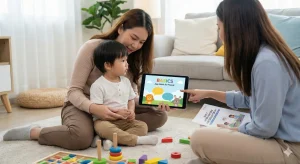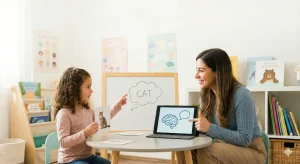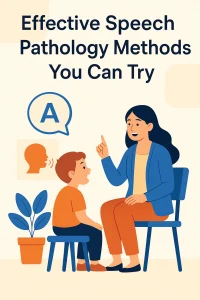Picture Exchange Communication System (PECS)
Last Updated: May 21, 2024
Picture Exchange Communication System, commonly known as PECS, is a transformative tool designed to bridge communication gaps for non-verbal individuals. Have you ever witnessed the frustration of someone who cannot use words to express themselves? Imagine the daily difficulties faced by those who struggle to understand their needs and desires. Communication barriers can deeply affect one’s ability to interact with the world, often leading to isolation and frustration. PECS is not just about teaching communication; it’s about opening a world of interaction for those who find verbal communication challenging. By enabling expressions, requests, and thoughts through simple picture exchanges, PECS offers a powerful solution to enhance communication and improve quality of life.
What is PECS?
Have you ever thought about how challenging life would be if you couldn’t use words to express what you feel or need? For many non-verbal individuals, this is a daily reality. However, a unique communication tool called the Picture Exchange Communication System (PECS) is changing lives by enabling a powerful form of non-verbal interaction.
Understanding PECS
PECS is an innovative augmentative and alternative communication system that allows individuals who cannot speak to use pictures to convey their needs, desires, and observations. By physically exchanging a picture of an item, they can effectively communicate with others around them, whether it’s asking for a favorite toy or expressing a need for a meal.
A Brief History
Developed in 1984 by Lori Frost, MS, CCC/SLP, and Dr. Andrew Bondy, PECS was initially used at the Delaware Autistic Program. It began as a means to assist children with autism in communicating functionally in a fast, self-initiating way. Starting with simple icons and gradually building up to more complex “sentences,” PECS has evolved into a globally recognized communication aid used across diverse settings.
Why PECS Matters
For individuals struggling with verbal communication, PECS offers more than just a method to express needs; it opens a pathway to enhanced interaction with the world. This system not only aids personal expression but also reduces frustration and behavioral issues linked to communication barriers. Its effectiveness is backed by numerous studies, highlighting significant improvements in social skills, behavior, and even some speech development.
How PECS Works: The Steps Simplified
Mastering the Picture Exchange Communication System (PECS) involves several phases, each building on the previous one to develop a comprehensive communication skill set. Let’s break down these phases so you can see how PECS progresses from simple picture exchanges to more complex forms of communication.
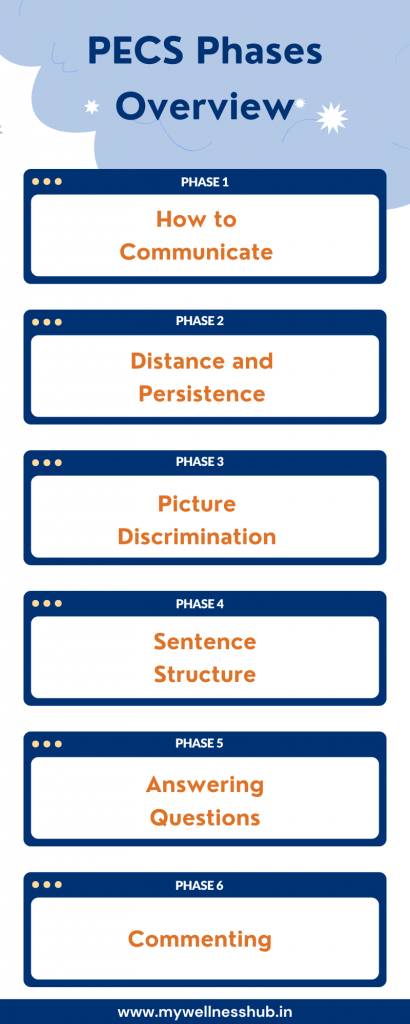
Phase 1: How to Communicate
The journey begins here. In this initial phase, individuals are taught the core of PECS: exchanging a picture for something they want. This might be a picture of a favorite toy or a snack. The idea is simple—hand over a picture to receive the item in return. This direct exchange teaches the basic yet powerful concept of communication through images, setting the groundwork for more complex interactions.
Phase 2: Distance and Persistence
As learners become comfortable with the basic exchange, they are encouraged to use their new skills in different environments and with different people. This phase focuses on generalizing the skill, ensuring that the individual understands that communication isn’t limited to one person or setting. Whether at home, in school, or in a park, the ability to communicate remains consistent, and the learner is encouraged to persist in initiating communication, even when the first attempt isn’t successful.
Phase 3: Picture Discrimination
Now that the basics are in place, individuals move on to choosing between multiple pictures. This phase enhances decision-making skills as the communicator must select the appropriate picture that best represents their current desire or need. For instance, choosing between a picture of a ball and a picture of an apple requires understanding that each picture has a different outcome.
Phase 4: Sentence Structure
Communication becomes more sophisticated in this phase. Learners start to build simple sentences on a detachable sentence strip. They begin with an “I want” picture followed by a picture of the item they are requesting. This phase helps not only to express needs but also to start understanding and constructing basic sentence structures, paving the way for more complex language use.
Phase 5: Answering Questions
At this stage, individuals use PECS to answer questions, particularly “What do you want?” This encourages responsiveness to others’ inquiries and begins to shift communication from just expressing needs to interacting with others’ requests. It’s a significant step towards interactive communication.
Phase 6: Commenting
In the final official phase of PECS, individuals learn to comment on their environment or respond to questions like, “What do you see?” or “What do you hear?” This moves beyond basic requests and builds a foundation for more dynamic and expressive language skills, such as describing, commenting, and later, sharing feelings and opinions.
Through these six phases, PECS facilitates not just basic communication but the development of a language system for individuals who otherwise might not have a way to express themselves. Each step is crucial, building confidence and skills that enrich the communicator’s interactions and overall quality of life.
Benefits of Using PECS
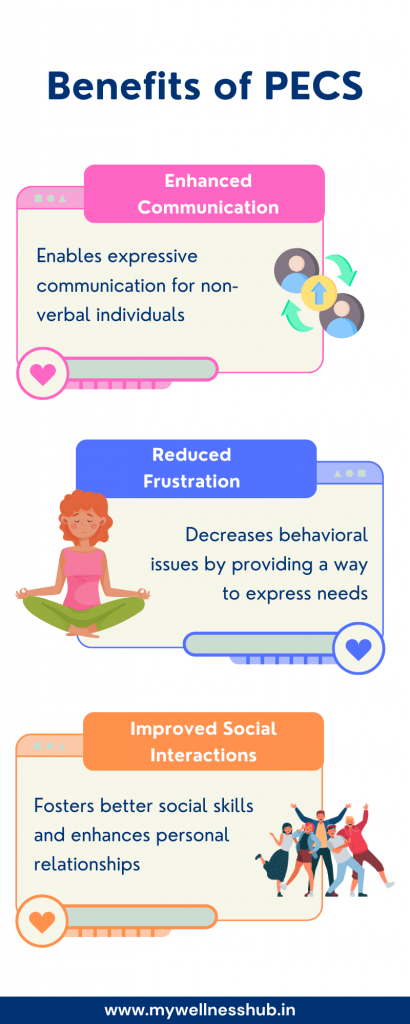
The Picture Exchange Communication System (PECS) is more than just a communication method; it’s a gateway to new opportunities for individuals with limited verbal skills. Let’s explore the tangible benefits that PECS provides, not only enhancing communication but also improving overall quality of life.
Enhanced Communication Abilities
PECS empowers individuals by giving them a voice through pictures. This system is especially beneficial for those who find verbal communication challenging. By facilitating the expression of needs, desires, and thoughts, PECS significantly enhances the communicative abilities of its users, enabling them to convey messages that were once trapped inside.
Reduction in Frustration and Behavioral Issues
One of the most immediate benefits of PECS is the noticeable decrease in frustration and negative behaviors. When individuals can express their needs clearly, there’s less likelihood of them resorting to tantrums or aggression as a means of communication. This improvement is often a relief to caregivers and educators, as it leads to more harmonious home and educational environments.
Improved Social Interactions and Relationships
Communication is the foundation of all social interactions. PECS not only aids in basic exchanges but also fosters the development of personal relationships. Users learn to initiate interactions, respond to others, and participate in social exchanges, enhancing their social skills and expanding their social networks.
Anecdotal Evidence and Case Studies
The effectiveness of PECS is supported by countless success stories from around the world. For instance, consider the case of a young boy with autism who struggled with severe communication barriers. After introducing PECS, he began to form connections with his family and peers, previously a significant challenge. Over time, he not only used PECS to request items but also started using words, showing remarkable improvement in his ability to communicate.
Moreover, schools and therapy centers report that integrating PECS into their programs leads to better educational outcomes and more engaged learning experiences. Children and adults alike show greater interest in participating in classroom activities when they can express their thoughts and needs.
Why PECS at Wellness Hub?
At Wellness Hub, we understand the transformative impact that effective communication tools like PECS can have. We’re committed to supporting families, educators, and healthcare professionals with resources that make communication accessible. By integrating PECS into our support offerings, we aim to enhance the lives of individuals facing communication challenges, ensuring they have the tools they need to express themselves and connect with the world around them.
Common Challenges and Solutions in Implementing PECS
Implementing the Picture Exchange Communication System (PECS) can be a transformative step toward improving communication for individuals with speech and language challenges. Whether you’re a parent, caregiver, or educator, starting with PECS might seem daunting at first, but with the right approach, it can lead to significant progress. Here are some practical tips and strategies to help you begin this journey effectively.
1. Start Simple
Begin with simple, highly desirable items that motivate the individual. This could be their favorite food, a beloved toy, or a preferred activity. Use clear and vivid pictures representing these items. Initially, focus on single exchanges to build confidence and understanding of the basic concept of PECS.
2. Maintain Consistency and Patience
Consistency is key in any learning process, especially with PECS. Use the system regularly and throughout the day to make it a natural part of communication. It’s also important to be patient. Every individual learns at their own pace, and some may take longer to adapt to the system than others. Celebrate small victories to encourage both the learner and yourself.
3. Personalize the PECS System
Customization can greatly enhance the effectiveness of PECS. Adapt the system to fit the individual needs and preferences of the user. This might mean using photos instead of illustrations if they are more recognizable to the person or arranging the communication book in a way that is most intuitive for them. Understanding what works best for the individual will make the process more enjoyable and successful.
4. Engage in Real-Life Situations
Integrate PECS into daily routines and real-life situations. This practical application helps reinforce the relevance of the system, making it clear that these communications have meaningful outcomes. Whether it’s asking for a snack during break time or requesting a favorite book before bedtime, real-life practice solidifies the utility of PECS.
5. Train with Peers and Family Members
Involving peers, family members, and other regular contacts in the PECS training can foster a more supportive environment. When everyone understands and uses the system, it helps normalize the method of communication, providing the user with more opportunities to interact and express themselves.
6. Seek Professional Guidance
If you’re unsure about how to proceed or if the individual faces unique challenges, don’t hesitate to seek advice from professionals trained in PECS. Speech-language pathologists and special educators with experience in PECS can provide valuable insights and support, ensuring the system is implemented in the most effective way possible.
PECS vs. Other Communication Aids
| Criteria | PECS | Sign Language | AAC Devices |
|---|---|---|---|
| Cost | Low to moderate. Mainly for materials. | Low. Costs associated with training. | High. Includes device and software. |
| Ease of Use | Moderate. Requires training and practice. | High. Requires extensive training and fluency. | Moderate to high. Setup and customization may be complex. |
| Portability | High. Lightweight materials that are easy to carry. | Very high. No materials are required; use only hand movements. | Moderate. Depends on the device size and mobility needs. |
| Effectiveness | High for non-verbal individuals. Immediate response. | High, but requires both parties to understand sign language. | High. Versatile and can be adapted to many levels of communication needs. |
| Accessibility | Good. Easily integrated into various environments. | Limited. Not all people are familiar with sign language. | Good. It can be used in most environments but may require electronic support. |
| Visual Support | Excellent. Uses clear images to convey messages. | None. Relies on hand gestures. | Good to excellent. Visual support depends on the device’s capabilities. |
Conclusion
The Picture Exchange Communication System (PECS) is more than just a way to talk; it’s a key to a new world for those who find it hard to speak. PECS helps people communicate better, reduces frustration, and improves relationships. It’s useful for anyone who cares for or teaches others, giving them a way to express their needs and feel heard.
We encourage you to see if PECS could help you or someone you know. At Wellness Hub, we are committed to making communication easier for everyone. Visit our website to find more information and join a supportive community. Together, we can make a big difference, helping everyone share what they feel and connect with others.
Frequently Asked Questions:
1. What is PECS in communication?
PECS, or Picture Exchange Communication System, is a communication tool that uses pictures to help individuals express their needs, thoughts, and feelings. It is especially helpful for those who have limited verbal skills, such as children with autism.
2. How does the Picture Exchange Communication System work?
The system works by teaching individuals to exchange pictures for items or activities they want. Starting with simple requests, it gradually builds up to more complex forms of communication, including forming sentences and answering questions.
3. Who can benefit from using PECS?
PECS is beneficial for individuals of all ages who have difficulty with traditional spoken communication. This includes children and adults with autism, speech delays, or any condition that affects their ability to communicate verbally.
4. Why is PECS effective for communication?
PECS is effective because it allows individuals to initiate communication through a visual medium, which can be easier than using verbal speech. It also reduces frustration and improves social interactions by giving users a method to express their needs clearly.
5. Can PECS improve spoken language skills?
Yes, many users of PECS also see improvements in their spoken language skills over time. The system encourages understanding and use of language concepts, which can help in developing speech.
6. Where can I learn how to implement PECS effectively?
Wellness Hub offers resources and training on how to implement PECS effectively. You can visit our PECS Training and Resources page to learn more and find helpful guides and workshops.
7. What are some common challenges when using PECS and how can they be addressed?
Some common challenges include resistance to new communication methods and difficulty in generalizing skills across different settings. Overcoming these challenges often involves consistent practice, personalization of the system, and professional support from specialists.
8. What materials are needed to start with PECS?
To begin using the Picture Exchange Communication System, you’ll need a set of picture cards, which can be custom-made or purchased. These pictures represent objects, desires, actions, or emotions that are relevant to the user’s daily life. Additionally, a binder or Velcro board can be useful for organizing and accessing the cards easily.
9. How long does it take to see results with PECS?
The time it takes to see results with PECS can vary widely depending on the individual’s unique needs and abilities. Some may show immediate interest and quick progress, while others might take longer to adapt and respond to the system. Consistent practice and adaptation to the learner’s pace are crucial.
10. Are there any advanced techniques in PECS for experienced users?
Yes, for individuals who have mastered basic PECS phases, advanced techniques include expanding vocabulary, using attributes (such as colors or sizes), creating complex sentences, and engaging in more abstract forms of communication, like commenting on past or future events. These advanced skills continue to build the user’s communication abilities and offer more ways to interact with others.
About the Author:
Anuradha Karanam
Speech-language pathologist (7+ years of experience)
Anuradha Karanam is a skilled speech-language pathologist with over 6 years of experience. Fluent in Tamil, Telugu, Hindi, and English, she specializes in parent counseling, speech sound disorders, fluency assessment, and speech-language evaluations. Anuradha excels at working with children with developmental disorders, offering creative and effective therapy programs. Currently, at Wellness Hub, she holds a BASLP degree and is registered with the RCI (CRR No A85500). Her patience, ambition, and dedication make her a trusted expert.
Connect with Anuradha to learn more about how she can help you or your loved one find their voice.
Book your Free Consultation Today
Parent/Caregiver Info:
Client’s Details:
* Error Message
